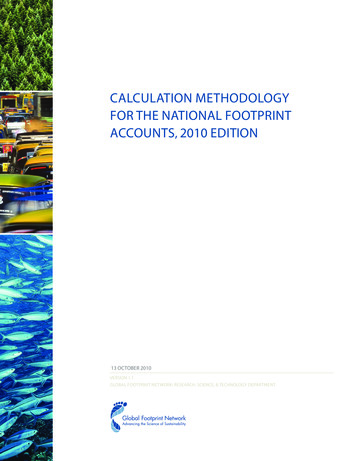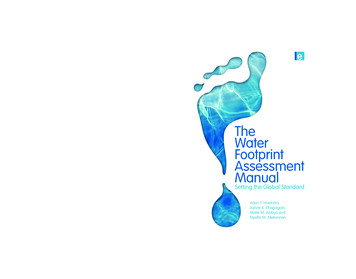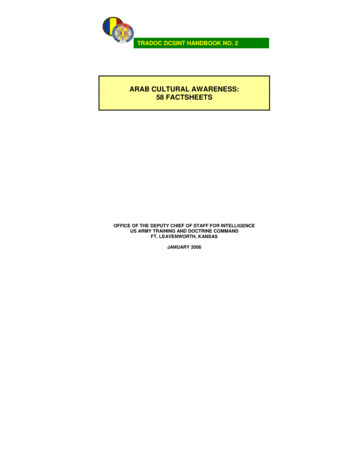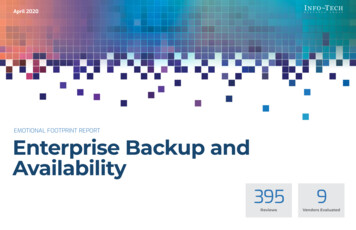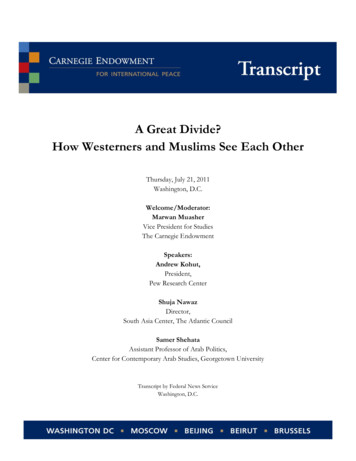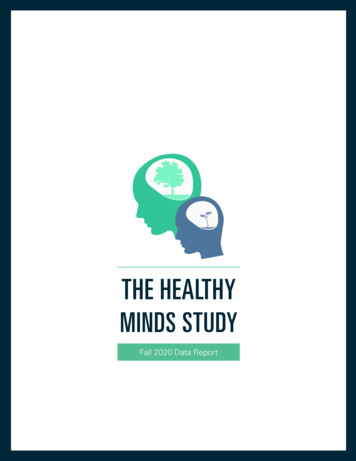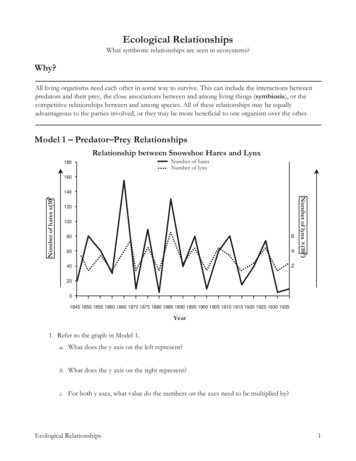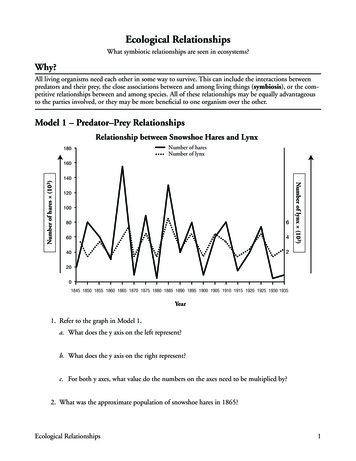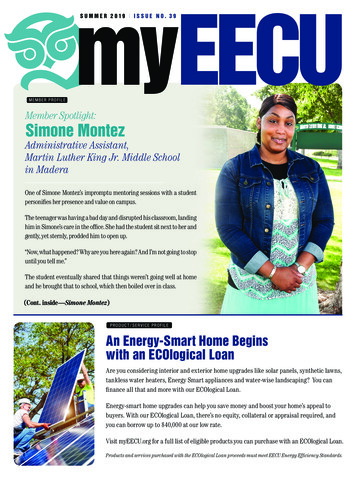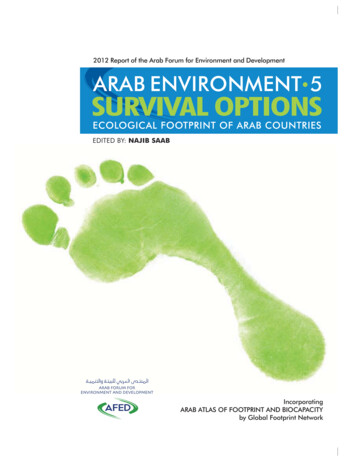
Transcription
2012 Report of the Arab Forum for Environment and DevelopmentARAB ENVIRONMENT 5SURVIVAL OPTIONSECOLOGICAL FOOTPRINT OF ARAB COUNTRIESEDITED BY: NAJIB SAABIncorporatingARAB ATLAS OF FOOTPRINT AND BIOCAPACITYby Global Footprint Network
Dedicated toMohamad Kassas1921-2012
ARAB ENVIRONMENT t5SURVIVAL OPTIONSEcological Footprint of Arab CountriesEDITED BYNAJIB SAAB2012 REPORTOF THEARAB FORUMFORENVIRONMENTANDDEVELOPMENT
2012 Arab Forum for Environment and Development (AFED)Published with Technical Publications and Environment & Development magazineP.O.Box 113-5474, Beirut, gAll rights reserved. No part of this book may be reproduced in any form by any electronicor mechanical means without permission in writing from AFED.AFED and respective authors are solely responsible for opinions expressed in this report.The contents are based on best available data. Sponsors and supporting organizationsdo not necessarily endorse the views expressed in this report.Editor: Najib SaabAssociate Editor: Bashar ZeitoonSenior Advisers: Mohamad Kassas, Mostafa K. Tolba, Mohamed El-AshryGraphics and Production Manager: Charbel MahfoudAssistant Copy-Editor and Researcher: Rosalyn SaabExecution: Jamal AwadaPrinting: Chemaly & Chemaly, BeirutPhotos: Environment & Development magazine archive - iStock photosISBN: 978-9953-437-43-9
ARAB ENVIRONMENT: SURVIVAL OPTIONSContents5PREFACE11EXECUTIVE SUMMARY15INTRODUCTION37CHAPTER 1Food Security and Agricultural SustainabilityAbdul-Karim Sadik69CHAPTER 2Sustainable Energy OptionsIbrahim Abdel Gelil83CHAPTER 3Population, Consumption, and Sustainability OptionsBashar M. Zeitoon105CONTRIBUTORS107ACRONYMS AND ABBREVIATIONSARAB ATLAS OF FOOTPRINT AND BIOCAPACITY5
CONTENTS
ARAB ENVIRONMENT: SURVIVAL OPTIONSPrefaceSurvival Options is the fifth in the series of annual reports produced by the ArabForum for Environment and Development (AFED) on the state of the Arabenvironment. It examines sustainability choices in Arab countries, based on asurvey of people’s demand for natural capital and available supply.The primary aim of the AFED annual reports is to foster the use of science inpolicy and decision-making in Arab countries. This is a manifestation of AFED’smission to advocate prudent environmental policies and actions based on scienceand awareness. Since 2008, AFED has produced four reports in the series: ArabEnvironment: Future Challenges (2008), Impact of Climate Change on ArabCountries (2009), Water: Sustainable Management of a Scarce Resource (2010) andGreen Economy: Sustainable Transition in a Changing Arab World (2011).The present report comes as a logical addition to the sequence, since it discussespossible paths to sustainability based on ecological constraints. As a basis forthe analysis, AFED has commissioned the Global Footprint Network, the worldleader in this field, to produce an Arab Ecological Footprint and BiocapacityAtlas using the most recent data available. The Atlas covers the 22 members ofthe League of Arab States, as a region, sub-regions and individual countries.The findings indicate that Arab countries’ demand for nature’s products andservices amounts to more than twice what ecosystems in these countries cansupply. This imbalance between domestic supply and demand for ecologicalservices places a limit on future growth and wellbeing.A group of experts has analyzed the findings of the Atlas, combined with theconclusions of previous AFED reports, in an attempt to go beyond pointing tothe signs of deterioration, towards providing alternative paths to development ina positive spirit. The analysis focuses on the challenges posed by the state of foodsecurity, water and energy, while considering main drivers such as populationand patterns of production and consumption.The report prescribes regional cooperation and sound management of resourcesas the main options for survival in a region characterized by stark variations inEcological Footprint, natural resources and income. In order to pursue sustainablewellbeing for all residents in the region, attention should be directed to achievingmore regional economic integration and to the promotion of inter-Arab tradefree of barriers, where the free flow of goods, capital, and people works to thebenefit of all countries.This report is dedicated to Mohamed Kassas, a pioneer ecologist and visionary whopassed away in March 2012. He was a staunch believer in regional cooperation7
8PREFACEamong Arab countries based on comparative advantages, and the role of scientificresearch in achieving real progress. Kassas, as he liked to be called, was behind theidea of producing a report examining sustainability options in the Arab region.We worked out the plan together, and held various meetings at his office in CairoUniversity to evaluate progress. Seeing the figures collected for the Footprint Atlasin December 2011, he thought that what the Arab region was facing amountedto not less than a struggle for survival. Thus, it was decided to change the title ofthe AFED report from Sustainability Options to Survival Options.When we proposed regional cooperation as an ‘option’, Kassas affirmed that itwas rather an obligation. To demonstrate his point, he asked the librarian to bringthe Club of Rome’s second report Mankind at the Turning Point, which proposedto divide the world into ten growth regions, and advocated cooperation withineach region and among each other. Kassas opened page 44 to show that, in 1974,the report specified the group of Arab countries as one of the ten growth regions.Kassas was a founding member of AFED’s Board of Trustees, who supported theorganization from the inception of the idea. The last time he traveled outsideEgypt was to attend AFED’s Board of Trustees meeting and its first AnnualConference in Manama in 2008. He contributed to all AFED reports, either asa scientific adviser or author. Mohamed Kassas was a world established scientist.To many of us, he was a mentor and a friend. But above all, he will always beremembered and missed for his kindness and unlimited capacity to give.AFED wishes to thank all those who made this report possible, especially ourpartners at the Global Footprint Network, alongside the authors and expertswho contributed to the contents and appraised the drafts. AFED’s special thanksgo to the Environment Agency-Abu Dhabi, the official sponsor, the OPEC Fundfor International Development, the Kuwait Foundation for the Advancementof Sciences, and all corporate and media partners who supported this endeavor.It is hoped that this report will help promote the integration of ecologicalaccounting into the decision-making process in the Arab region, to securesustainable growth.November 2012Najib SaabSecretary GeneralArab Forum for Environment and Development (AFED)
ARAB ENVIRONMENT: SURVIVAL OPTIONSState of the Arab Region at a glance: 1961-2008[constant US 2000 per capita][millions][Estimated][gha per capita][gha per capita][m3 per capita]9
ARAB ENVIRONMENT: SURVIVAL OPTIONSEXECUTIVE SUMMARYARAB ENVIRONMENT t5SURVIVAL OPTIONS2012 Report of the Arab Forum for Environment and Development (AFED)Measured by the increase in Gross Domestic Product (GDP) over the last50 years, Arab countries have performed well, with average GDP per capitaquadrupling in this time. But while this has often resulted in higher standardsof living, it has not always translated into a better quality of life nor has itenhanced the chances of sustainable living. Over the same period, availablenatural resources in the region have fallen to less than half, and this, coupledwith deterioration in environmental conditions, has put the region on the brinkof ecosystem bankruptcy. Not only does this situation impose limits on futuregrowth and wellbeing, but it also threatens survival prospects in the region,according to the 2012 Annual Report of the Arab Forum for Environment andDevelopment (AFED).The Arab region entered into a state of steady ecosystem deficit in 1979 andthe consumption levels of life-supporting goods and services are today morethan twice what local ecosystems can provide. This has been accompanied witha doubling in the regional Ecological Footprint and a decrease in freshwateravailability by nearly four times.These are some of the key findings of the Arab Footprint and Biocapacity Atlas,prepared by researchers at the Global Footprint Network, as part of AFED’sAnnual Report on survival options in Arab countries. The Atlas analyzes thedemand for resources (footprint) and available supply (biocapacity), expressedin global hectares (gha), to shed light on the resource constraints in Arabcountries from the perspective of the regenerative capacity of nature.ECOLOGICAL FOOTPRINT AND ENVIRONMENTAL DEGRADATIONToday most Arab countries suffer an ecological debt. Compared to 1961, theaverage Ecological Footprint of the region has increased by 78 percent, from1.2 to 2.1 global hectares per capita. There are two main drivers which have ledto this sharp jump: The first is a 3.5-fold increase in population size, leadingto higher overall consumption; the second is a sharp rise in the amount ofresources and services consumed per person as a result of higher incomes andchanging lifestyle patterns.The available average biocapacity per capita in Arab countries decreased by60 percent over these 50 years, from 2.2 to 0.9 gha. This sharp decline ismainly attributed to the vast increase in population size and the decline in theproductive capacity of the region’s ecological systems due to pollution, habitatdestruction, and overall inadequate resource management.11
12EXECUTIVE SUMMARYThe vast deficit in the region’s ecological resources is largely bridged by importsand an over-exploitation of finite local resources. This is an unsustainablestrategy, the AFED report warns, as in the long term, overuse will lead to an evengreater depletion of natural resources and degradation of the environment.On the one hand, the dependence on global trade imports introduces concernsof economic insecurity, often driven by soaring food prices, disruptions in globalsupply chains, and trade restrictions. For oil-importing countries, carrying debtto finance imports imposes burdens on their economies and places a limit onfuture wellbeing.And on the other hand, inadequate resource management has dire consequenceson the environment. The AFED annual reports on the state of Arabenvironment have repeatedly warned that overexploitation of resources, theimpact of climate change, high population growth rates, uncontrolled economicgrowth and urbanization amplify the region’s environmental challenges andconstrain its ability to manage them. Significant among those challenges arewater scarcity, land degradation, inadequate waste management, coastal andmarine environment degradation, and air and water pollution. AFED reportshave estimated the cost of environmental degradation in the Arab region as awhole at 5 percent of total GDP, while budgetary allocations for environmentalpurposes do not even come close to 1 percent of GDP in any Arab country.According to data in the Footprint Atlas, Arab countries’ individual EcologicalFootprints exhibit vast variations. The average resident of Qatar has the highestEcological Footprint in the world (11.7 gha per capita), exceeding by nine timesthe Ecological Footprint of the average Moroccan. Kuwait and the United ArabEmirates have the second and third highest footprint per capita in the world,respectively.To put this into perspective, if all humans lived like the average Arab resident,1.2 planets would be required. If they lived like an average resident of Qatar, 6.6planets would be required to satisfy their level of consumption and emissionsof carbon dioxide. By contrast, if everyone lived like an average person inMorocco, humans would demand only three-quarters of the planet Earth.Disparity is also reflected in many other forms, such as freshwater availabilityper capita - which varies between 8 cubic meters in Kuwait and 3,460 cubicmeters in Mauritania - and GDP which currently varies between aboutUS 1,000 in Sudan and Yemen to above US 92,000 in Qatar.For some Arab countries, such as Yemen, the average inhabitant’s footprint issmall compared to the world average, and even too small to meet basic food,shelter, health, and sanitation needs. Therefore, the deficit cannot be bridgedby simply reducing the demand for resources. To improve the quality of life,the actual per capita share of renewable natural resources must become morebalanced and equitable across countries. Innovative resource management isneeded to achieve this.The Atlas also indicates that the carbon footprint component has been the onlyone to increase significantly since 1961, with energy consumption growingfaster in the Arab region than in any other part of the world. This reflectsthe proliferation of energy-intensive industries and the increasing demand for
ARAB ENVIRONMENT: SURVIVAL OPTIONSelectricity and transport from a growing population, often characterized bywaste and inefficiency.CHANGING COURSEIn light of the resource constraints in Arab countries, this AFED report isconcerned with achieving economic prosperity while simultaneously ensuringecological health. It seeks to investigate what level of resource consumption ismost appropriate for Arab economies, given the available natural capital.Addressing these questions demands a shift in economic policy formulationby accounting for national ecological endowments. Decision makers in Arabcountries will need to look beyond GDP as the sole measure of performance,and must seek to complement traditional economic analysis with data onresources consumption and availability.Setting development targets is naturally considered a sovereign nationalright, but economic growth must take into account ecological limits and thecapacity of nature to sustainably support life. Given the low efficiency withwhich resources are turned into final products, Arab countries must improvethe resource productivity of their economies by prioritizing energy and waterefficiency.While the AFED report warns of increasing food deficits, it also revealsthat if the major Arab cereal producers raise their productivity and enhanceirrigation efficiency only to match the world average, they will be able to meetdemand. However, achieving food security requires regional cooperation, asoften it cannot be realized at isolated country levels without causing graveenvironmental effects. An additional concern for Arab countries in this regardis the depletion of strategic reserves of scarce groundwater.Regional programs in scientific research are key to achieving sustainable andequitable growth for all. One crucial step is to make good use of the presentincome from the region’s finite oil resources to build a strong science andtechnology base, as a step to securing survival and the best possible quality oflife in the post-oil era.CONCLUDING REMARKSArab countries are facing an urgent challenge: how to provide sustainablewellbeing for all inhabitants and not simply seeking growth for the sake ofgrowth at any cost.The AFED 2012 report has found that no Arab country can survive as anisolated entity. However, the diversity of natural and human resources in theArab region offers a foundation for survival and renewal. But this demandsregional economic cooperation and Arab trade free of barriers, where the openflow of goods, capital, and people would work to the benefit of all countries inthe region. Arab countries need to function as interdependent entities. This isparticularly true in an era when the world is steadily moving towards regionaltrading blocs, based on practical common interests.As gloomy as its findings might sound, this report does not seek to plant fear13
14or despair about resource deficits. Rather, it seeks to stress the need to changecourse based on a hopeful vision for the Arab region. In this regard, the AFEDreport tracks glimpses of hope, with some Arab countries starting to genuinelyrespond to the warnings. The UAE, for example, which boasts the third largestfootprint in the world, has launched a pioneering national footprint initiativeintended to manage the country’s ecosystem deficit and facilitate the adoptionof science-based policies to advance sustainable development. The MasdarInstitute of Science and Technology in Abu Dhabi and the King AbdullahUniversity of Science and Technology in Jeddah are recent examples of regionalinitiatives to advance sustainable development by promoting research in cleanand renewable energy, along with food and water security.The AFED report on survival options is a call to Arab countries to embracecollective action to advance a new sustainable economic and ecological vision.Regional cooperation, resource efficiency, and balanced consumption are theoptions for survival. Action is needed now.
ARAB ENVIRONMENT: SURVIVAL OPTIONSINTRODUCTIONECOLOGICAL FOOTPRINT ANDSURVIVAL OPTIONS IN ARAB COUNTRIES2012 Report of the Arab Forum for Environment and Development (AFED)OVERVIEWArab countries’ demand on nature amounts to more than twice what the ecosystemsin these countries can actually support. This disparity, particularly significant interms of food, is largely bridged by imports and the over-exploitation of localresources.Such an operating model is not sustainable. It is also economically dangerous,considering the increasing costs of imports, the impact on local and globalenvironments, and the eventual depletion of non-renewable energy resources.The AFED 2012 annual report discusses survival options in Arab countries basedon analysis of the demand on nature (footprint) and available supply (biocapacity).It provides a detailed account of resource consumption and recommends soundresource management and regional cooperation, not only as a means to achievingsustainability, a stable economy, and a good quality of life, but also for survival itself.This report seeks to state the facts, since ignoring signs of deterioration will notsolve the resource deficit problem the Arab world faces. But AFED does notseek to promote a doomsday prophecy. On the contrary, the current situationcan be reversed, if it receives the attention it merits. Therefore, this report callsfor recognizing the challenges and finding alternative paths for development in apositive and constructive spirit.The report asks central questions about resource management in the Arab region,and seeks to provide options for action. What might be the implications for Arabeconomies as they become increasingly dependent on resources they do not have?How can the region achieve energy sustainability, while reducing its air pollutionand carbon footprint? How can the region achieve a proper balance betweenresource availability and the need for development, given current demographictransitions? What are the limits of using irreplaceable natural resources at rates thatcannot be sustained? How can Arab countries replace policies that promote growthfor growth’s sake by ones that promote growth for the sustainable wellbeing ofpeople? How can resource development, resource efficiency, and alternative pathsto sustainability help achieve these transformations? How can Arab countriessubstitute food and water self-sufficiency, which entails the impossible task ofrelying completely on a country’s internal resources, with the more practicalalternative of resource security, which can be achieved by establishing mutuallybeneficial regional trade and investment cooperation, to boost their sustainability15
16INTRODUCTIONCREDITOR-DEBTOR STATUS FOR ARAB COUNTRIES IN 1961 AND 2008 SHOWS SHARP ECOLOGICALFIGURE 1DETERIORATION. RED SHADING INDICATES THAT THE FOOTPRINT IS GREATER THAN BIOCAPACITY(DEBTOR STATUS), WHILE GREEN SHADING INDICATES THAT BIOCAPACITY IS GREATER THAN THEFOOTPRINT (CREDITOR STATUS).19612008Ecological Footpint.Q 150 % larger than biocapacityQ 100 - 150 % largerQ 50 - 100 % largerQ 0 - 50 % largerBiocapacity.Q 0 - 50 % larger than FootprintQ 50 - 100 % largerQ 100 - 150 % largerQ 150 % larger
ARAB ENVIRONMENT: SURVIVAL OPTIONSoptions as a bloc? Beyond questions of political economy, what ethical values areneeded to govern thinking about consumption and lifestyle?Addressing these questions requires going beyond traditional economic thinking.Making more effective policy decisions demands a shift in the accounting of nationalecological endowments. Therefore it is necessary to incorporate ecological accountingin economic policy formulation. In other words, policy makers and leaders in Arabcountries will need to look beyond Gross Domestic Product (GDP) as the cornerstonemeasure of performance, and seek to complement traditional economic analysis withinformation on renewable resource consumption and availability. In this new era ofeconomic insecurity, tracking the demand for natural capital is essential to meetingthe basic needs of food and water security, and ultimately to ensuring economiccompetitiveness while strengthening ecological health.As a basis for this analysis, AFED has cooperated with the Global FootprintNetwork (GFN) to produce an Ecological Footprint and Biocapacity Atlas,exploring ecological constraints in Arab countries.The system of ecological footprint accounting, developed by GFN, measureshuman demand on nature. It does so by linking all human demand for food, fiber,urban space, and waste absorption -- such as CO2 -- to biologically productiveareas needed to provide these services. This demand is people’s ecological footprint.Ecological accounting also tracks how much of this productive area is available inthe world or in a particular country. By keeping books of demand for and supply ofnature, this accounting system provides an ecological balance statement, evaluatingthe endowment of ecological services compared to what people consume.Both footprint and biocapacity are expressed in global hectares (gha). By standardizinghectares and scaling them proportionally to the regenerative capacity on that hectare,this unit allows analysts to compare demand and supply across the world.Based on this accounting methodology, the Arab Atlas documents trends overthe period from 1961 to 2008, the last year data is available. It covers the 22members of the League of Arab States as individual countries, sub-regions, andas a whole region. At a glance, the Atlas shows rapidly developing constraints innatural capital: All countries of the region exhibit vast ecological deficits today,except for Sudan and Mauritania, although the region as a whole was an ecologicalcreditor in 1961, as illustrated in Figure 1.The Atlas reveals figures that are critical for understanding the region’s competitiveadvantages and disadvantages, among which are:sssssSince 1979 the region as a whole has been experiencing a biocapacity deficit,with its demand for ecological services exceeding local supply by more thandouble. In order to bridge this gap, ecological services have had to be importedfrom outside the region.The average resident in Arab countries demands more than twice what isavailable locally.The average ecological footprint per capita in Arab countries increased by 78percent from 1.2 to 2.1 global hectares per capita over the past 50 years.The available average biocapacity per capita in Arab countries decreased by 60percent over the time period 1961-2008.Population has increased by 250 percent over the same time period; the17
18INTRODUCTIONsssoverall regional ecological footprint has therefore increased by more than 500percent.Only four countries make up more than 50 percent of the Arab region’sEcological Footprint: Egypt (19 percent), Saudi Arabia (15 percent), theUnited Arab Emirates (UAE) (10 percent), and Sudan (9 percent).Only two countries provide approximately 50 percent of the biocapacity inthe Arab region in 2008: Sudan (32 percent) and Egypt (17 percent).If all humans lived like the average Arab citizen, 1.2 planets would be requiredto satisfy human’s resource needs. If they lived like an average resident ofQatar, 6.6 planets would be required to satisfy this level of consumption andemissions of carbon dioxide. By contrast, if everyone lived like an averageYemeni, humans would demand only half of planet Earth, however this wouldnot adequately meet basic human needs.These findings indicate that the region has already approached an imbalancebetween domestic supply and demand for ecological services, putting at riskfuture economic expansion and stability, and, simultaneously, human wellbeing.While almost all Arab countries are in a state of biocapacity deficit, the demandon resources, or footprint per capita, varies vastly among individual countriesand regions. Other than the GCC countries, which record some of the highestfootprint figures in the world, the average inhabitant’s footprint in other partsof the region is small compared to the world average, and in many cases it is toosmall to meet basic food, shelter, health, and sanitation needs. Therefore, thedeficit cannot simply be bridged by reducing the demand for resources. For vitalquality of life improvements, large segments of the region’s population mustinstead have greater access to renewable natural resources. Meeting this needwill involve multiple strategies: large improvements in resource efficiency toachieve more output while also utilizing lower input and generating less waste,and the expansion of biocapacity without resource-intensive production.Arab countries should be concerned because ecological deficits constraindevelopment and threaten economic and social security. There are multiplesources that bring about these constraints. One source stems from overdependence on imports to meet the demand for primary products. Thismakes Arab countries vulnerable to disruptions in global supply chains, traderestrictions, and price volatilities. The financing of these imports presentsanother source of economic constraint. For oil-exporting Arab countries, fossilfuel resources are inherently finite and crude oil price levels are highly subjectto global economic cycles, all of which heighten the risks of an extractive, onesource economy. For low-income Arab countries, which finance their importswith external borrowing and foreign assistance, debts and interest paymentsdiminish their prospects for economic security. Economically, ecological deficitscannot be addressed by relying on imports indefinitely.To close the resource deficit gap and boost biocapacity, Arab countries haveintensively exploited local renewable and non-renewable resources, causingdegradation to economically important environmental assets. The annualAFED reports of 2008 through 2011 on the state of the Arab environment havedocumented the effects of overexploitation and resource mismanagement.As a result of agricultural intensification and overgrazing, land degradation inArab countries has now affected 34 percent of all irrigated farmlands, 67 percent
ARAB ENVIRONMENT: SURVIVAL OPTIONSof rain-fed farmlands, and 83 percent of grazing lands. In doing so, many Arabcountries have also over-extracted groundwater resources at rates higher than theability to recharge. This is coupled by low rates of irrigation efficiency at less than40 percent. The increased demand for water has reduced per capita supply to onequarter of the level it was in 1960. Within a decade, it is expected that the averageannual freshwater availability in Arab countries will be below 500 m3, which isjust 10 percent of the world average, and falls below the severe water scarcitymark. Currently, 13 Arab countries are among the world’s most water-scarcecountries, and per capita water availability in eight of them is below 200 m3 peryear. In spite of this, the amount of water consumed for personal domestic use insome of the most water-scarce Arab countries is among the highest in the world-- mostly coming from expensive desalination of sea water. Only 40 percent ofwastewater is treated, and less than one-third of the treated water is re-used.These conditions limit human development and are a threat to life.In Arab countries, the carbon footprint portion accounts for 45 percent of thetotal Ecological Footprint. This indicates high rates of energy consumptionto meet urban demand and fast growing key economic sectors includingconstruction, transportation, mining, industrialization, and tourism. Theenvironmental impact of the largely inefficient fossil-fuel burning on the qualityof air has been significant. In 2011, Kuwait, Saudi Arabia, and the UAE wereamong the 10 countries with the worst air pollution in the world. Rising asthmarates among children is linked to the deterioration of air quality. The annualhealth care costs of air pollution in 16 Arab countries have been estimated tobe US 10.9 billion in 2008, equivalent to 1.2 percent of their combined GDP.Anthropogenic climate change, caused by global CO2 emissions, is predictedto cause rainfall to decrease by 25 percent and evaporation rates to increaseby 25 percent in Arab countries by the end of the 21st century, which wouldcause average yields of rain-fed agriculture to decline by 20 percent overall,aggravating the risks of food and water shortages. In addition, 18,000 kmof inhabited coastal areas will become vulnerable to rising sea levels. Otherenvironmental damage afflicting coastal and marine areas includes overfishing,as well as pollution by municipal waste, industrial discharge, and agriculturalrun-offs brought about by the large number of coastal petrochemical and energyinstallations, uncontrolled tourism, and extensive urban development.Escalating ecological footprints in Arab countries indicate higher consumptionrates by institutions and households and consequently rapidly increasing ratesof waste generation, including municipal solid waste (MSW), demolition waste,and electronic waste. The quantity of MSW alon
ARAB ENVIRONMENT: SURVIVAL OPTIONS 7 Preface Survival Options is the fifth in the series of annual reports produced by the Arab Forum for Environment and Development (AFED) on the state of the Arab environment. It examines sustainability choices in Arab countries, based on a survey of people's demand for natural capital and available supply.
